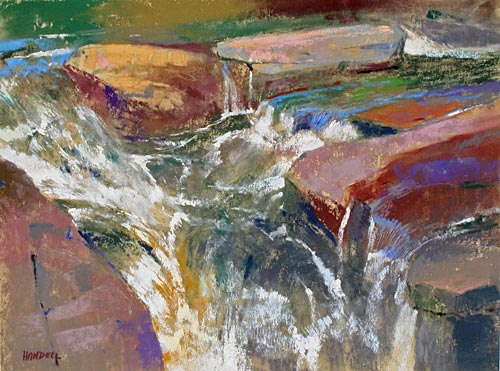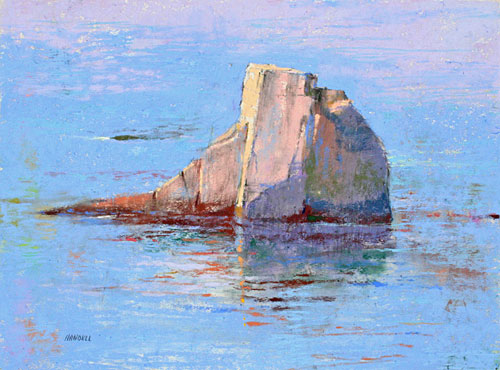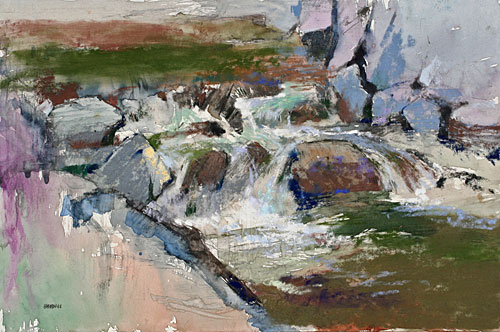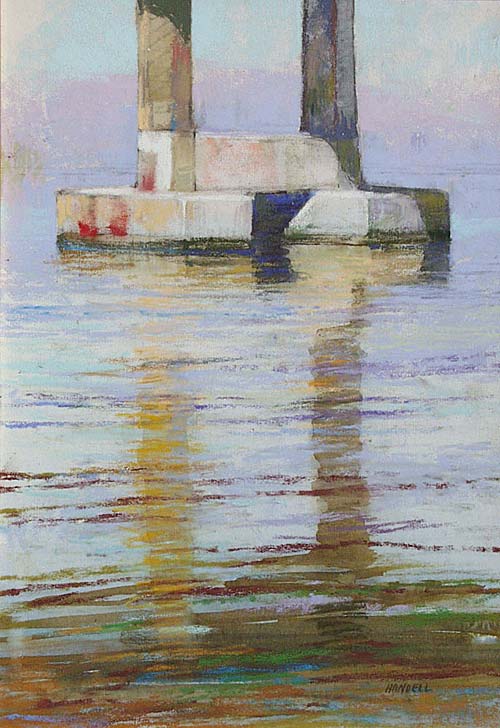Painting Water with Albert Handell

In the August issue of The Pastel Journal, Albert Handell demonstrates, step by step, how he approaches the painting of a flowing mountain stream, beginning with a robust drawing and watercolor underpainting, followed by pastel, to capture the subject’s intense energy and motion. As a landscape painter, Handell has painted water in all its many forms—lake, river, ocean cove—and has learned from his experience. Here, he shares some insights for capturing the magic of water in pastel:
Painting the Ocean
The ocean bobs up and down and moves forward. The tides change each and every day. Rocks may be in the path of the waves as the waves are moving and bobbing up and down. A lot of artists like to paint the wave as it rises, the moment before impact. There are some lovely translucent greens to the upright plane of these waves at the moment before crashing. It’s very exciting and I can understand why so many artists go after this moment as the basis for their paintings. But, personally, I like the moment after the wave has hit the rocks and is in the process of receding. For me, there’s more rhythm and clearer movement to the water as it recedes. That excites me.
Consider a rock (one rock) and a wave. As the wave rises, there is less rock exposed. As the wave recedes, more rock is seen. The relative proportion of ocean and visible rock changes every moment. This can be tricky to nail down. If painting the ocean is new to you, start your endeavors at low tide or the low end of the tide. It’s less active then, and may be easier to analyze and paint.
Another important consideration to keep in mind is that the ocean appears flat as you look out at the horizon. The water becomes a mirror of sorts for the colors of sky. If the sky is blue there will be a bluish cast to the ocean. If another part of the sky has gray or white sunlit clouds overhead, they will also reflect on the ocean surface.

[Free download! Landscape Art: 4 Lessons on Creating Luminous Landscape Paintings]
Painting Water Reflections
Reflections, in my mind, might be the easiest water to paint, and possibly the most colorful. Basically, what’s above the water is reflected in the water. The primary thing to keep in mind is that what is above the water has stronger edges, lighter lights, darker darks and richer chroma compared to what is reflected in the water. There are two distinct ways to capture this effect.
First, don’t paint the reflected blacks as dark as the blacks above the water, and don’t make the whites as light as the whites. In other words, leave the strongest values above the water; choose weaker pastels of the same colors for the reflections. Another option is to use the very same colors in the reflections as are in the object that’s being reflected, except add to the area of reflection a sense of the water. In other words, try to blur the intense colors in the reflected area.
In either approach, make sure that the edges in these reflections are softer than edges above water. Sometimes, for a final touch, I may softly feather some charcoal over the reflections in the water. This mutes everything in the reflected area and plays it down.




Look for Albert Handell’s step-by-step painting demonstration of a mountain stream in the August 2010 issue of The Pastel Journal.
MORE RESOURCES FOR ARTISTS
• Watch art workshops on demand at ArtistsNetwork.TV
• Online seminars for fine artists
• Instantly download fine art magazines, books, videos & more
• Sign up for your Artist’s Network email newsletter & receive a FREE ebook





Have a technical question?
Contact UsJoin the Conversation!